You’ve invested so much time and energy into your e-Commerce business, products, SEO, and website design.
But for some reason, your conversion rate is not improving.
Hypothetically speaking, various factors may be negatively affecting your conversion rate.
And one of those may have to do with your copy – specifically on your product descriptions.
Contrary to popular belief, writing product descriptions is not all about describing the product. Persuasive product descriptions go beyond mentioning features.
The goal should be to provide customers with all of the information they need while still making them want to click “buy” or add the product to their cart.
But how do you strike a balance between a product description that is detailed and at the same persuasive? We’ve got an answer, and we are going to delve into that in this article. Keep reading…
What is a product description, and why is it important?
A product description is a copy that explains what a product is and why potential buyers should buy it. In other words, it is that piece of information that convinces and converts a new buyer.
ALSO READ: The Mighty Product Page: Rethinking Product Descriptions
After reading your product description, potential customers should understand in detail the features and benefits they will enjoy after purchasing.
Over the years of optimizing different product pages, we have noticed that the most persuasive product descriptions are written using customers’ words.
What do I mean by that, you ask?
I mean, you first have to talk to customers to know precisely their pain points before you even attempt to sell them something.
The words they will use as they describe their pain points or how they use your product are what you should use to write your product descriptions. I’d advise using a Jobs-to-be-done framework when you talk to your customers so that they reveal social and emotional reasons behind a purchase.
When you write any of your marketing copy (including product descriptions) without speaking to your customers first, you are more likely to fall into the trap of writing something that only describes the product.
This is a mistake that we have seen being made by seasoned marketers and copywriters.
Why is
Having said that, now let’s look at the reasons why you should have a product description:
Enhancing visitor conversion rates
Customers need enough information about the product before they purchase it online.
Without adequate information, it’s not enough to convince a stranger to trust that the product will help them make progress from their current situation.
In one study conducted by the Nielsen Norman Group, they discovered that 20% of purchases failures result from unclear product descriptions.
Your product description should also include essential details such as:
- Price,
- Shipping costs,
- Product availability,
- Product specifications (e.g., color, size)
- Product features etc
All of the above details have to be in one place instead of having links lead off to other pages where they may or may not get the relevant information they are looking for.
Increases website visibility on search engines
Using the right keywords on your product descriptions will make it fast for your potential buyers to find your products.
But, using product descriptions to increase the website visibility on search engines brings up this difficult question:
How do you find the right keywords, and is there a strategic way of using them?
The idea here is to narrow down to the correct phrase and pay attention to the following factors:
- Keyword difficulty
- Search volume
- Related terms
For instance, suppose you are selling a product that has to do with tea. Let’s say the tea that you are selling is good for weight loss.
Without narrowing down your keyword, you will be up against heavyweight sites, and it will be super hard to rank for the word tea:
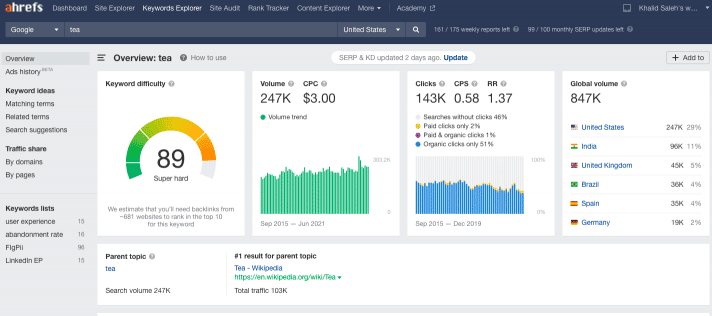
But if you narrow it down the keyword and have a targeted phrase like slimming tea, you can identify a keyword that is relatively easy to rank for:
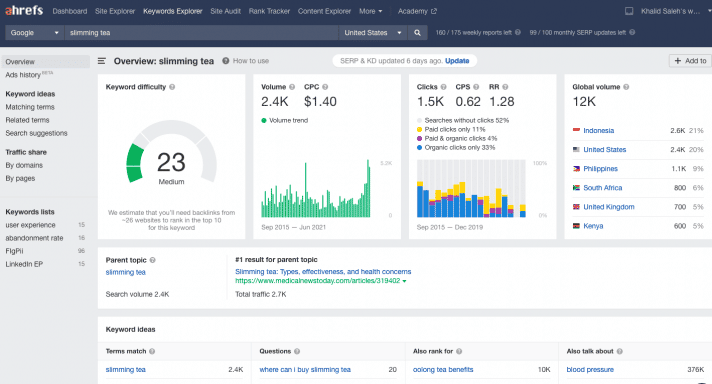
As you can see from the image above, you won’t be competing with gigantic sites for keyword ranking when you narrow down your keyword.
One more thing to remember when optimizing your product descriptions for search engines is to make sure that you write for people first. The reason?
Search engines do not make purchase decisions. People do. Search engines are not going to use your products. Only people can do that. And 99% of the time, when it’s good people, it will be suitable for search engines.
According to Julia McCoy:
“The whole point of search is to help users find exactly what they’re looking for. If your product descriptions align with this goal, you’re going to please Google and rank well.“
One more thing you have to avoid when optimizing your product descriptions for search engines is keyword stuff. Injecting a keyword over and over again in your product pages will not help you rank. It’s better to have it:
- Once in your product page URL.
- Mention it once in your product description title.
- Mention the keyword twice (depending on the copy length) in the product description.
- Have it once in the alt image tag.
Enhance customer experience
Let’s face it, when a potential customer lands on your website and they are looking for a particular product, chances are they have a few questions.
- How long does it take to deliver this product?
- Do they have different colors?
- Do they have different sizes?
Even if you sell a simple product like a t-shirt, they may want to know the sizes, colors, and delivery options.
Without that detailed information, customers are more likely to leave your site and never come back again. And even worse, they might not trust your site ever again.
How to write product descriptions that sell
When a potential customer lands on one of your product pages, you have a few seconds to impress them before they leave. How are you going to make those precious few seconds count?
Easy. Use compelling words.
In other words, all I’m saying is your product description is what will make them stay or leave.
Here’s a list of tips you should think about when you want to write persuasive product descriptions:
Think about your target audience
Like any other marketing effort, a good product description starts with an understanding of your target audience.
If there’s no clear understanding of your target audience, then there’s no way to know what information to include or leave out in your product description. You can’t target everyone.
To figure out your buyer personas, here are some of the questions you should be asking yourself:
- Who are you writing your product description for?
- Are your customers older or younger?
- What kind of descriptions will they accept?
- Witty descriptions, or would they prefer generic ones?
- How do you want your customers to portray your brand?
When you know your buyer persona, you now know the words – to use – that your target audience can relate to. It’s even better to use some of their own words in your copy.
And, of course, the age group of your target audience determines the kind of words you will use. I mean, you wouldn’t want to use words like “dope, lit, flex” to describe your product to an older audience.
Don’t just talk about your business
The product description is not the place to mention your business. But it’s definitely the place to let your customers know how your product will solve their problems. All you have to do is set the scene that allows your customers to use their imaginations to envision themselves using your product.
For example, let’s say that you are selling webcams to professionals – you’d want to get your customers to imagine using the camera in a virtual meeting. You can use images and videos to create this visual experience.
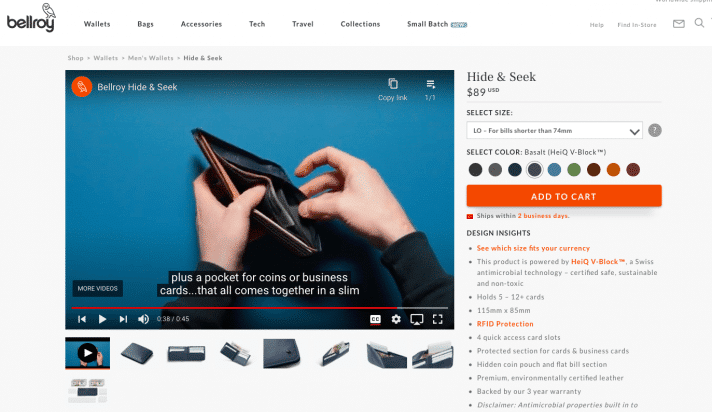
Bellroy is an excellent example of an online store that uses a combination of text, images, and videos – on its product pages – to create imaginations for its potential customers.
Write a clear and easily scannable copy
I get it. Having more words on every product page can help you rank well on search engines. But if you don’t have anything more to explain, don’t just add more words.
Avoid using generic phrases like “great design” or “high quality.” They don’t make you any better. Those phrases can be claimed just by anyone, including your competitors.
Take this example of beauty and wellness products from Skinny Me Tea.
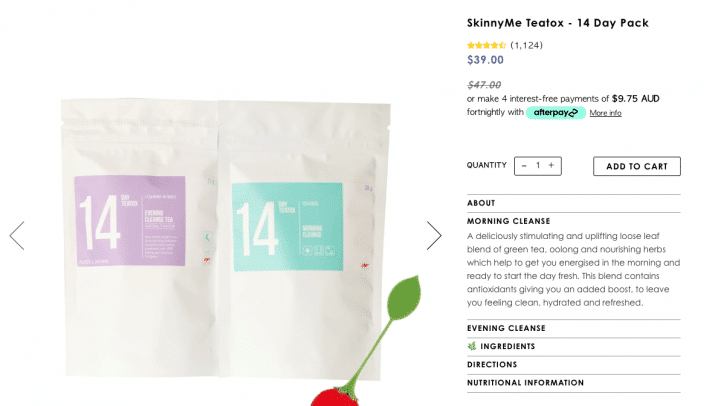
If you have never used a slimming tea before, would you know how to use it properly?
This brand does an excellent job of giving all the necessary information about the product itself. I mean, they tell you about the ingredients used in their products, how the product works, and the nutritional benefits you will get after drinking their tea.
Buyers who are ready to make a purchase need all of that information.
Looking at their product description and perhaps the brand’s name, you can tell that their targeted audience is “a person who wants to lose weight.”
Use both features and benefits
What motivates your targeted audience to make a purchase?
The answer to that question will help you know which features and benefits to injecting into your product descriptions.
According to Hubspot:
“Features describe what the product does, setting it apart from the competition. Benefits describe how the product can help the audience.”
When it comes to any marketing copy (including product descriptions), it’s typically better to take a benefits-heavy approach simply because what matters the most to customers is the value they will get after purchasing the product.
Check out this product description for a wellness and hydration product from Brandless:
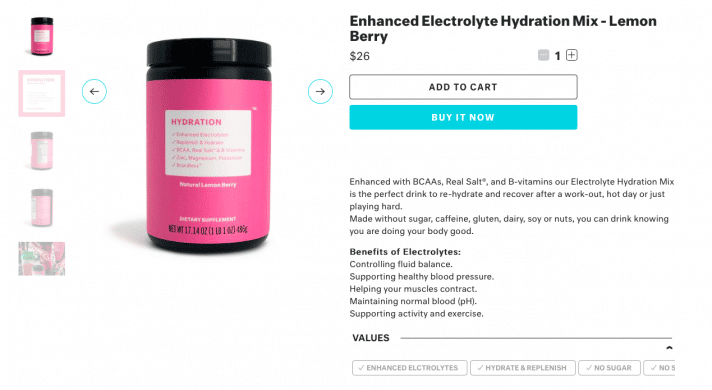
While the product description in the above image explains the ingredients used to make the lemon berry, the copy also includes five benefits that you will get after consuming this product.
Having a features-only product description bores readers. In fact, it sounds more like a manual. Every product, no matter how boring it is, has a problem it solves. Focus on the benefits it offers.
However, sometimes it makes sense to make features more prominent than benefits, especially when selling a well-known product like a watch, laptop, or phone. Everyone knows what watches, laptops or phones can offer in terms of benefits.
But not every watch, laptop, or phone has the same features – you can be forgiven for making your features more prominent in your product descriptions if your product is technical.
Do not have the same description for your products
Each product has to have a unique selling point that is different from other products you are selling. Duplicating descriptions and using them on different product pages can hurt your rankings on search engines.
When it comes to product descriptions, you are writing for humans, but at the same time, you have to please both potential customers and Google. Remember, for your customers to be motivated to make a purchase, they have to find your product first – and they can’t find it if you are not ranking well.
Entice with storytelling
Storytelling is a bit easy when writing a blog post. But when it comes to product descriptions, it’s definitely not that straightforward.
However, that’s exactly what you have to do if you intend to convince a stranger to buy from you.
For instance, let’s say you are selling bed mattresses and blankets. Everyone knows that a mattress helps one sleep comfortably, and blankets make you feel warm. If that’s what you only mention in your product description, then good luck motivating buyers to make a purchase.
But if you can talk about the inspiration behind making the product, this might entice potential buyers. Here’s an example from Tufina Watches:
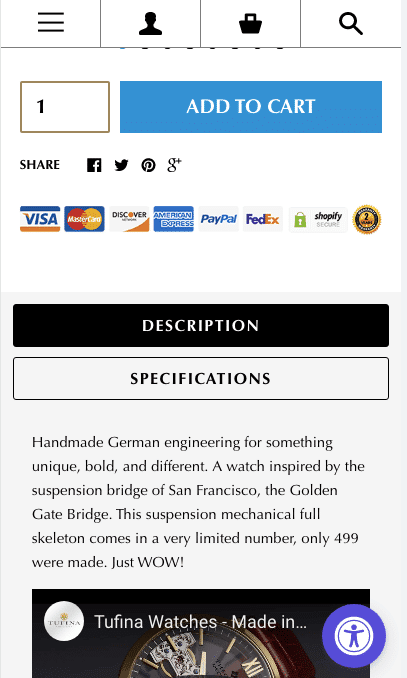
A phrase like “inspired by the suspension bridge of San Francisco, the Golden Gate Bridge” is convincing, and it convinces a potential buyer to actually make the purchase.
Conclusion: Reflect your value proposition
After all, has been said and done, a good product description should reflect your value proposition. Your product description is part of your marketing copy, so it makes sense to reiterate your value proposition on your product description. At the end of the day, you want customers to know what value they will get from your product.



